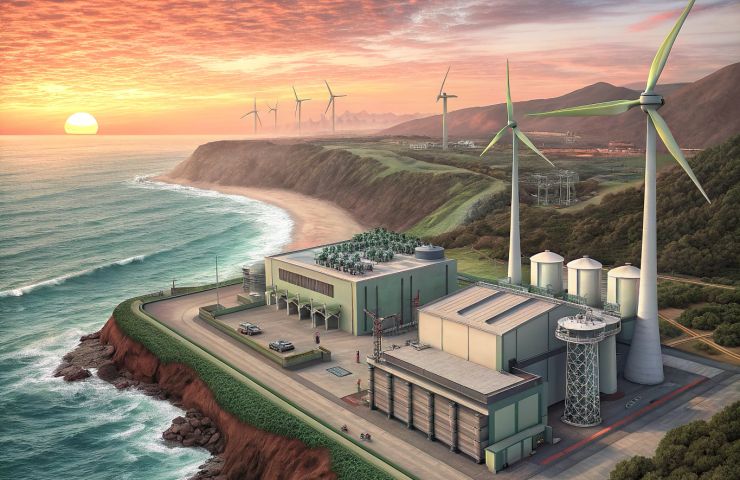
Hydrogen-Ready Turbines Can Revolutionize Los Angeles’ Scattergood Generating Station
October 30, 2025The Bold Move
Picture this: an 80-year-old power plant getting a 21st-century makeover. The Los Angeles Department of Water and Power (LADWP) Board of Water and Power Commissioners will cast votes on an $800 million green hydrogen retrofit of the Scattergood Generating Station. And no, it’s not just a new coat of paint—it’s about zapping the oceanfront plant with next-gen hydrogen-ready turbines. These babies can swap in up to 30% green hydrogen alongside natural gas. If approved, Scattergood becomes the marquee project in the city’s push for Los Angeles clean energy and a cornerstone of the LADWP hydrogen plan to kick fossil fuels to the curb by 2035.
This is more than a bold gamble—it’s a potential milestone for urban decarbonization. Visualize a peaker plant on the city’s western edge flexing its clean-energy muscles during heat waves and high-demand days. Instead of tearing down and rebuilding from scratch, LADWP is banking on retrofitting legacy infrastructure and putting hydrogen to the test in one of America’s largest municipal utilities.
Why It Matters
Los Angeles knows a thing or two about smog, heat waves and power hiccups. Even with all the solar panels and wind farms sprouting up, natural gas still powers nearly half of the region. That means CO₂ and nitrogen oxides continue to cloud the air in neighborhoods. Add to that the fact that California outlawed seawater cooling—Scattergood’s original chill method—over environmental concerns. So, the plant switched to dry cooling, but emissions are still a sticking point.
By blending in hydrogen, LADWP hopes to dial down carbon intensity and ease local pollution. But let’s be real: green hydrogen in California is still in its infancy, pricey and thirsty for water. With no robust supply chain yet, Scattergood will rely mostly on natural gas, making the true payoff and cost savings a bit of a question mark. Yet this initiative could serve as a crucial stepping-stone, bridging our current grid setup to the clean-energy vision we’re all chasing.
The Magic of Hydrogen-Ready Turbines
Now for the fun part: these are combined-cycle turbines that have been tweaked to co-fire hydrogen and natural gas. The secret sauce is in capturing exhaust heat in a secondary steam cycle, pushing efficiency higher than a simple gas turbine. When green hydrogen is in the mix, up to 30% of fuel burns carbon-free. It’s an elegant move—no extra real estate needed, just a swap in the fuel lineup.
Down the road, as water electrolysis powered by renewables scales up, that 30% cap could climb even higher. Right now, most hydrogen is grey or blue—pulled from fossil fuels or tied to carbon capture. And don’t forget: green hydrogen comes with a sticker price two to three times that of natural gas.
Still, these turbines are “future-proof.” They promise reliable operation on gas today and stand ready for greener fuels once they become affordable and plentiful. Think plug-and-play for the hydrogen economy as it catches up.
Behind the Scenes
Pulling off this retrofit is going to be a juggling act of policy and dollars. ARCHES, the California Hydrogen Hub public-private partnership, had pledged at least $100 million toward the overhaul. Then, in a twist, the Trump Administration yanked back $1.2 billion in federal hub funding and scaled back hydrogen tax incentives. Now, GO-Biz and LADWP are scrambling, tapping state and local pockets to fill the gap.
Overseeing power planning, Jason Rondou, LADWP’s Assistant GM for Power Planning and Operations, admits the federal cuts have muddied the financial waters. “We’re all-in on renewable hydrogen,” he says, “but we need solid funding lanes to make it happen.”
Then there are the critics. Julia Dowell from the Sierra Club warns this retrofit might just mask continued fossil-gas dependence under a green sheen, delaying genuine clean-energy projects in LA. And Dan Esposito at Energy Innovation asks if the money wouldn’t be better spent on tried-and-true solutions like solar farms and batteries instead of banking on a still-nascent hydrogen market.
Beyond the Beach
The Scattergood site on Playa del Rey has had its perks—stellar ocean views and endless seawater for cooling—until marine impacts led to a statewide cooling ban. LADWP swapped to dry cooling, but the plant’s carbon footprint has stayed stubbornly high. Throwing hydrogen into the mix promises cleaner local air and shows how coastal plants can marry modern environmental regulations with reliable power.
Everyone’s watching the bottom line: will ratepayers see a jump in bills if hydrogen stays scarce or expensive? LADWP has floated different financing options—from new bonds to small surcharges—sparking intense public scrutiny. Angelenos want to know how this $800 million price tag will affect their monthly tabs and the city’s climate targets.
On top of that, the fuel switch could benefit marine ecosystems by reducing thermal discharges. More efficient turbines mean less total water use for cooling, giving coastal habitats a much-needed breather.
Looking Ahead
If the board signs off, Scattergood becomes California’s largest municipal pilot for hydrogen blending. Contracts for procurement and engineering would kick off in early 2026, and the new turbines could show up by 2027. Securing hydrogen supply deals—possibly with electrolyzer projects in the Central Valley or offshore wind hubs—will need to move at warp speed.
This could be a game plan for other cities looking to upgrade old plants. Without the federal hub funding, state leaders will lean on partnerships like ARCHES and creative financing from GO-Biz. Investors and tech firms will be glued to this vote—if it works, hydrogen-ready turbines could shift from the demo stage to a mainstream power asset.
But if LA steps back, solar, batteries and microgrids might take center stage, reserving hydrogen for sectors that really need it. In that case, Scattergood could stay on natural gas until the tech and economics align.
At the end of the day, every Angeleno has skin in the game. Will the city lead the charge into a hydrogen-powered future or double down on immediate emission cuts with established clean-tech options? The next few weeks will make it clear which path LA chooses—and set the pace for California’s next chapter in energy innovation.


 With over 15 years of reporting hydrogen news, we are your premier source for the latest updates and insights in hydrogen and renewable energy.
With over 15 years of reporting hydrogen news, we are your premier source for the latest updates and insights in hydrogen and renewable energy.